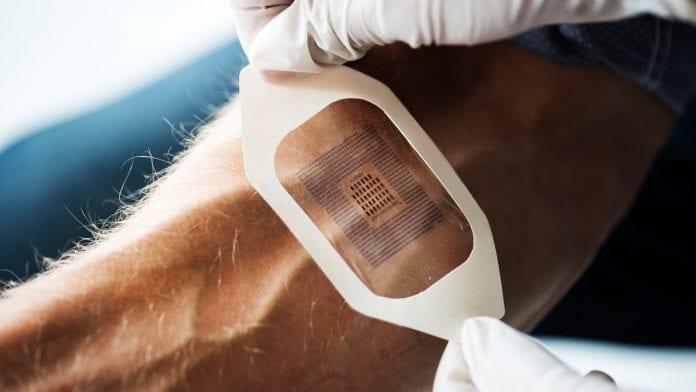
A wearable, smart insulin patch has been developed that could help to revolutionise diabetes treatment.
Researchers have developed a smart insulin-delivery patch that could one day revolutionise diabetes treatment by monitoring and managing glucose levels in people with diabetes – delivering the necessary insulin dosage.
UCLA bioengineers and colleagues at UNC School of Medicine and MIT have further developed the smart insulin patch, which is adhesive and about the size of a small coin.
In the study, researchers, led by Zhen Gu, PhD, professor of bioengineering at the UCLA Samueli School of Engineering, describe the studies that have been conducted on mice and pigs, and explains how the team is applying for FDA approval of clinical trials in humans. The team envisioned that the smart microneedle patch could be adapted with different drugs to manage other medical conditions as well.
The study was published in Nature Biomedical Engineering.
Revolutionising diabetes treatment
The smart adhesive diabetes patch monitors blood sugar (or glucose) and has doses of insulin pre-loaded in very tiny microneedles, less than one-millimeter in length, that deliver medicine quickly when the blood sugar levels reach a certain threshold. When blood sugar returns to normal, the patch’s insulin delivery also slows down. The researchers said the advantage is that it can help prevent overdosing of insulin, which can lead to hypoglycaemia, seizures, coma or even death.
Gu, former professor in the UNC/NCSU Joint Department of Biomedical Engineering, said: “Our main goal is to enhance health and improve the quality of life for people who have diabetes.
“This smart patch takes away the need to constantly check one’s blood sugar and then inject insulin if and when it’s needed. It mimics the regulatory function of the pancreas but in a way that’s easy to use.”
Insulin is a hormone naturally produced in the pancreas helps the body regulate glucose, which comes from food-consumption and provides the body with energy. Insulin is the molecular key that helps move glucose from the bloodstream to the cells for energy and storage. Type 1 diabetes occurs when a person’s body does not naturally produce insulin. Type 2 diabetes occurs when the body does not efficiently use the insulin that is produced. In either case, a regular dosage of insulin is prescribed to manage the disease, which affects more than 400 million people worldwide.
The treatment for the disease hasn’t changed much in decades in most of the world. Patients with diabetes draw their blood using a device that measures glucose levels. They then self-administer a necessary dose of insulin. The insulin can be injected with a needle and syringe, a pen-like device, or delivered by an insulin pump, which is a portable cellphone-sized instrument attached to the body through a tube with a needle on the end. A smart insulin patch would sense the need for insulin and deliver it.
“It has always been a dream to achieve insulin-delivery in a smart and convenient manner,” said study co-author John Buse, MD, PhD, director of the UNC Diabetes Center and the North Carolina Translational and Clinical Sciences (NC TraCS) Institute at the University of North Carolina at Chapel Hill School of Medicine. “This smart insulin patch, if proven safe and effective in human trials, would revolutionise the patient experience of diabetes care.”
How the diabetes patch works
The microneedles used in the patch are made with a glucose-sensing polymer that’s encapsulated with insulin. Once applied on the skin, the microneedles penetrate under the skin and can sense blood sugar levels. If glucose levels go up, the polymer is triggered to release the insulin.
Each microneedle is smaller than a regular needle used to draw blood and do not reach as deeply, so the patch is less painful than a pin prick. Each microneedle penetrates about a half millimetre below the skin, which is sufficient to deliver insulin into the body.
In the experiments, one quarter-sized patch successfully controlled glucose levels in pigs with type I diabetes for about 20 hours (he pigs weighed about 55 pounds on average).
Co-author Robert Langer, ScD, the David H. Koch Institute Professor at MIT, said: “I am glad the team could bring this smart insulin patch one more step close to reality, and we look forward to hopefully seeing it move forward to someday help people with diabetes.”
The technology has been accepted into the US Food and Drug Administration‘s ‘Emerging Technology Program’, which provides assistance to companies during the regulatory process. The researchers are applying for FDA approval for human clinical trials, which they anticipate could start within a few years.
Do you want the latest news and updates from Health Europa? Click here to subscribe to all the latest updates, and stay connected with us here.








Can the smart insulin patch work for type 1 diabetes and if so could I request more info on how this works. Is this patch available for United states residents
Hey Crystal,
The artical says:
“The researchers are applying for FDA approval for human clinical trials, which they anticipate could start within a few years.”
So.. They are not even in clinical trials (experimenting) on humans yet, let alone it being available..
I suggest you watch this space.
Regards,
Another watcher..
So many people with type 1 diabetes lives would be so much easier with this patch. I hope it can become a priority in research It would be so welcome.